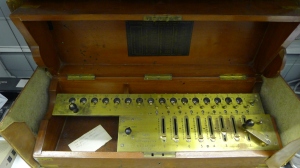Do you know what an Arithmometer is for? Check out the National Mutual Life Association of Australasia Objects Collection Available Soon..

In this post industrial era devices such as the stapler, photocopier and computer have
become ubiquitous features of daily office life. We have come to rely on them
to save us time and effort on tasks that once required hours of labour, but
where did they come from and what did the original inventions look like?. The
National Mutual Life Association of Australasia NMLA collection held at the
University of Melbourne Archives UMA contains a treasure trove of nineteenth
and twentieth century office machines, that once had an active life and were
considered to be innovative technology in their day. These objects which now
serve as artefacts from a bygone era can still provide us with insight into
what working life might have once been like. Machines such as the ‘Arithmometer’,
invented in the 1870s were used in acuturial science from the mid 1880s and there
is surviving evidence that that tells us the ‘Arithmometer’ with its modern
levers and switches was once a highly valued and prized object because it had
been well looked after and stored in its own specially handcrafted carry case.
The ‘Magnaphone K54 model’ a small grey chrome plated box with a prominent gold
mesh amplifier produced in 1948 could be considered to be the forerunner of the
handsfree technology we take for granted today because it was one of the first
inventions which allowed company employees to conduct ‘handsfree’ conversations
on standard phones. The inscription on the front cautions the user to ’Always
replace handset on your telephone after using magnaphone’. Sound advice!
The finding aid for this fascinating office collection,which will be available through the UMA
online catalogue in April 2014 will provide scholars and researchers interested in mechanical curios and office memorabilia with a wealth of detail and images. UMA would also like to thank Shane Talia, Cultural Heritage student intern for all his work on the NMLA objects project.
Leave a Reply